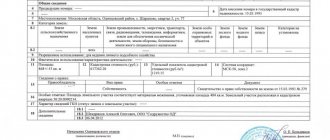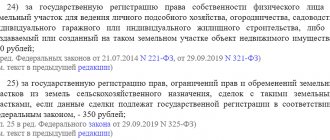The concept of land allocation
Among the methods of forming land plots, allocation occupies a special place. This is a system of cadastral and land management work associated with the separation of a share or shares from the total land plot in the area. When selected, one or more new objects can be created. In this case, the original area from which the allocation is made continues to exist within the changed boundaries.
Allocation of a land plot is possible when the object being converted is in common shared ownership. This legal regime is regulated by Chapter 16 of the Civil Code of the Russian Federation.
A distinctive feature of shared ownership is that the shares of co-owners are known in advance. In addition, they can be unequal, for example: ½ + ¼ + ¼. For comparison: the shares of joint owners are determined only at the time of division of property. As a general rule they are equal.
A plot can become the object of common shared ownership for various reasons: inheritance, transaction, foreclosure on the debtor’s property.
Co-owners often find it difficult to determine what rights they have to the plot. By default, the shared ownership regime is established (Article 224 of the Civil Code of the Russian Federation). The right of joint ownership is typical for the common property of spouses (by default), for farm assets (by agreement).
The Russian Land Code does not limit the range of possible shareholders. The site being converted may simultaneously be owned by:
- citizens;
- foreigners;
- organizations;
- states;
- municipalities.
How to divide the land
Current legislation provides that several people may have the right to own a plot of land. If the share for each owner is established, then such real estate is in common shared ownership. Despite the fact that the right to own such property has many advantages, owners often come to the conclusion about dividing it.
This process is not an easy task, given that co-owners do not always have a common position regarding this issue or that there are buildings on the land plot.
The division of common shared ownership of a land plot can take place in two ways: voluntarily or judicially.
Converted and allocated land plots
A land plot is a special object of property rights, which is a part of the earth’s surface with an established border. Its legal regime is determined simultaneously by civil and land legislation. Like other individually defined things, a plot can be divisible or indivisible. According to Art. 133 of the Civil Code of the Russian Federation, property that cannot be divided in kind without changing its intended purpose is recognized as indivisible.
The Land Code of Russia has clarified these requirements in relation to plots. The latter are recognized as divisible if they can be divided into parts, each of which forms a self-sufficient plot, the permitted use of which can be carried out without being transferred to land of a different category. This provision takes on special significance in relation to agricultural land. When selecting, we are talking about the following objects:
- the initial section from which one or more parts are extracted. As a result of the procedure, it does not cease to exist, but is only transformed. The area of such a site decreases, its boundaries change.
- a newly formed plot or plots that did not previously exist as independent objects of civil and land law. They appear in connection with the separation.
For clarity, let us compare the composition of the initial and resulting objects during separation (Article 11.5 of the Land Code of the Russian Federation) and division (Article 11.4 of the Land Code of the Russian Federation). In the latter case, the original plot, which serves as the territorial basis for the placement of newly formed plots, ceases to exist as an independent object of law.
Common ownership of a plot of an apartment building
Participants in the shared construction of multi-storey new buildings, after putting the house into operation, settling in with its residents and receiving a certificate of share in the right to an apartment, have a choice regarding the land adjacent to the house. It consists of options:
- Lease rights from the municipality.
- Ownership.
This issue is resolved at a general meeting and with the consent of all residents, the site allocated for the functioning of this residential building can be privatized. Each resident has equal rights to use the site.
Typically, the site is used for the arrangement of children's playgrounds, flower beds, parking lots and other needs of the residents of the house.
After privatization, the share of each resident in the right to the plot is determined in proportion to the share in the right to residential premises . But in apartment buildings such rules are practically not accepted, since they deprive residents of the benefits that common use gives them.
Formation of a land plot by allotment
An exclusive list of methods for creating land plots is stipulated by Art. 11.2 Land Code of the Russian Federation. Among them are:
- the only primary one is the allocation from undemarcated lands that are in municipal or state ownership;
- several secondary ones (section, allocation, merger, redistribution), involving the transformation of existing plots.
Thus, the concept of “allocation of land”, depending on the context, may have a different logical scope.
- Creation of a new object of civil law from virgin lands - previously unused spaces that are in public ownership. Municipal and state owned lands in Russia are still not demarcated. The plots of them have not been formed; they have not been registered with the state real estate cadastre and the Unified State Register of Real Estate. The development of such lands for various purposes (integrated development, laying pipelines, gardening) is inevitably accompanied by the allocation of plots, the definition and recording of their legal regime in the State Property Committee, the Unified State Register.
- Transformation of a land plot owned by two or more shareholders, according to the rules of Article 11.5 of the Land Code of Russia or in accordance with the requirements of Federal Law No. 101 “On the Turnover of Agricultural Land”, the transformation of a land plot is carried out in the process of land management by determining the boundaries of the allocated plot, clarifying the boundaries of the original plots.
Share sizes
They are determined according to the norms of the Civil Code. As a general rule, co-owners can agree among themselves and decide which part each of them will own. If such an agreement has not been drawn up, the territory is divided into equal parts.
In some cases, the size of the share may change. For example, two sisters own a dacha plot and their shares are equal. But one hasn’t been to the dacha for several years, and the other has been cultivating the land, renovating the house, laying out a garden, laying out paths, and putting up a gazebo. Such transformations, by law, are recognized as inseparable improvements to property. And the sister who contributed them has the right to demand in court an increase in her share.
Legal consequences of land allocation
The legal consequences of the allocation of a land plot may be as follows:
- The original (transformed) site changes its area and boundaries, otherwise its legal regime remains the same.
- The newly created (allocated) plot is taken into account as an independent property. By default, it acquires the legal regime of the original object: it belongs to the same category and territorial zone, and the same types of uses are allowed in relation to it.
- After the allocation, easements and encumbrances continue to operate within the same legal scope and territorial boundaries.
- The shareholder, upon whose application the plot is allocated, becomes its sole owner. He loses the right of shared ownership of the reduced original plot.
- The remaining shareholders retain their rights to the transformed plot, and their shares increase proportionally. Considering that the area of the common property has decreased, objectively the scope of the rights of the co-owners remains the same, that is, in the event of a division, they will be able to claim the same area as before.
Arbitrage practice
Practice shows that reports from expert organizations are of key importance when a judge makes a decision on a case under consideration. To carry out this examination, courts usually use the services of proven specialists with whom they have collaborated on numerous occasions, but at the same time, the parties have the right to involve another expert organization or a private person in the consideration of the case at their discretion.
After issuing an expert opinion, the court will offer two options for further developments:
- Division of land . This option involves the creation of several land plots on the site of the original one. After receiving such a court decision, the owners will be able to begin marking the boundaries of the plots, registering the property and obtaining certificates of ownership.
- Establishing a procedure for using such a site . This exit is expected if it is impossible to divide the disputed property. The court will take into account the size of the shares of each owner and the actual procedure for using the plot, but the owners will have to continue to be neighbors and also jointly own real estate.
Important! The only way out is for one of the participants to allocate their share in kind for the purpose of its further sale, while the primary right to purchase such property by other co-owners must be taken into account.
Example: The owners of a land plot and a residential building located on it decided to divide the land under the house, but did not come to a common denominator, since their ownership documents indicate equal shares - ½ each, and the land plot of one of the owners (Petrova A .) 20% larger in area.
As a result of the trial, the court, with the involvement of experts, established:
- It is possible to divide a plot without dividing a house. Since the house is a single structure, but with isolated premises belonging to each of the owners;
- The land plot, taking into account the expert’s opinion, was divided in strict accordance with the share values. This required changing the configuration of the yard;
- The right of common shared ownership of both the house and the land plot was terminated.
The procedure for allocating a land plot to shared ownership
Art. 252 of the Civil Code of the Russian Federation guarantees the shareholder the opportunity to demand the allocation of his share from the common property. The procedure is carried out on the initiative of one or more co-owners of the site, which is in shared ownership.
To carry out the allocation, the consent of all interested parties is required, including tenants, mortgagees and pledgees (Article 11.2 of the Land Code of the Russian Federation). The opinion of the persons in whose favor the easement is established is not sought.
The allocation of a share of a land plot in kind can be the result of:
- the decision of the shareholders adopted at the general meeting on the application; interested person;
- court verdict.
The decision of the general meeting of shareholders approves:
- land surveying project;
- a list of owners of the created plots, if there are several of them;
- recalculation of shares for the original plot.
If a plot is formed on the basis of a decision of a meeting of shareholders in accordance with the land surveying project approved by this meeting, then additional approval of the location of the boundaries of the new plot is not required. Otherwise, the owner of the allocated share turns to the cadastral engineer. The latter, on a contractual basis, prepares a land surveying project for allocation against the land share.
The size of the allocated plot is determined on the basis of documents certifying the right to a land share. Taking into account the specific configuration of the land plot and the properties of the soil, the final area of the allocated plot may differ from that indicated in the title documents, up or down. Persons whose rights have been violated may request monetary compensation.
Partition on a voluntary basis
A voluntary procedure is primarily characterized by the consent of all owners of the disputed property to such a division. This procedure can be quite varied, for example, when allocating shares, one participant will receive a house and the land under it, and the second will receive a large part of the land plot.
The order of this process, as well as the order of actions, depend on many factors such as:
- area of allocated area;
- the total size of the land plot, since in each locality the minimum dimensions of the boundaries of plots are established;
- its intended purpose, etc.
Important! Shares of a land plot can be established by the owners at the stage of its acquisition. If such actions were not carried out, and the division is impossible, then the division will occur equally both in kind and in the legal sense.
Each newly created plot has certain limits in its size, and therefore the division of the specified real estate may be unfair in relation to individual owners.
Example: Dividing an allotment into three owners is impossible due to the non-compliance of the minimum provided by regional rules with any of the allocated areas. In this case, one of the participants can claim monetary compensation for his share, and the land will be divided among the two remaining owners. The third will receive the agreed compensation taking into account the market price of the plot, but will lose the right to common real estate.
The size of the land plot when dividing the land plot
In order to begin the procedure for allocating a share of a land plot, it is first necessary to determine the area of the newly formed land plot, which should not be less or more than that established by law.
In each region of the Russian Federation, local governments have established their own maximum and minimum permissible sizes for the specified areas. Thus, in the Moscow region the following standards are defined for plots allocated from joint ownership:
- For agricultural land – from 2 to 4 hectares;
- For horticultural needs - from 0.06 to 0.15 hectares;
- On lands for establishing a vegetable garden - from 0.04 to 0.1 hectares;
- To build a summer house - from 0.06 to 0.25 hectares.
Partition process
If the owners find common ground on the issue of dividing the common land plot, the latter will need to take the following actions:
- Determine the boundaries of newly created land plots, draw up land survey plans and approve them;
- These documents are subject to submission to the administration authorities at the location of the allotment for subsequent approval by the head of the department of the draft new borders;
- A division agreement is concluded between the parties, certified by a notary;
- After completing these procedures, a full package of documents is submitted to the Registration Chamber or multifunctional center for registering ownership of new plots.
To complete this procedure, the following package of documents is submitted to the Registration Chamber:
- Documents certifying ownership of real estate, for example, a purchase and sale agreement or a privatization act;
- Cadastral documentation of the site;
- Division agreement certified by a notary;
- Written consent of persons related to the disputed plot, for example, banking organizations, if the plot is pledged to the latter;
- Documents confirming payment of the state duty.
Sample voluntary separation agreement
The procedure for the voluntary division of a land plot by participants in shared ownership must necessarily be accompanied by the preparation and execution of an appropriate agreement.
The document is drawn up in writing and reflects all essential conditions and data. You will need to indicate:
- Date and place of drawing up the agreement;
- Full names of the parties, their passport details, registration and residence addresses;
- Specifications for a land plot: information about the right; register and cadastral numbers; special purpose; location; square;
- The achieved conditions for dividing the plot are described: to whom, in what size, under what conditions. Compensation and costs for processing changes are also stipulated;
- Signatures of the parties;
- Notarization.
The sample agreement presented below can be used for information in a simple dispute, but to draw up a more complex document, it is better to seek help from experienced lawyers. Consultation with our specialists on the website is completely free!
Allocation of land through the court
If the shareholders were unable to reach an agreement on the method and conditions for dividing the common plot, the interested party has the right to allocate the land plot through the court on the basis of Art. 252 of the Civil Code of the Russian Federation. Based on the results of the consideration of the case, the court has the right to refuse the plaintiff-shareholder if the allocation is impossible without disproportionate damage to the common property associated with the impossibility or inconvenience of its use for its intended purpose (clauses 35, 36 of the joint Resolution of the Plenum of the Supreme Court and the Supreme Arbitration Court dated 01.07.96 No. 6/8 ).
In case of refusal, the interested party is faced with a choice: to remain a co-owner of the property or to demand monetary compensation from the remaining shareholders. As a general rule, replacing the allocation of a land plot in kind with such compensation requires the initiative of the right holder.
However, the court has the right to make such a decision on its own initiative without the consent of the shareholder if:
- its share is insignificant;
- it cannot be isolated in nature for technical reasons;
- the shareholder is obviously not interested in using the common plot.
If the allocation is carried out through a court, the latter’s verdict is recognized as a document of title and a full replacement for the decision of the general meeting of shareholders for the purposes of state registration.
Registration of land allocation
A shareholder interested in the allocation will receive significant relief when registering with the State Property Committee. To form a site you only need:
- application for registration of a newly formed facility;
- documents necessary for its cadastral registration.
The state does not oblige the shareholder who is allocating a land plot to submit an application for registration of changes in the boundaries and area of the converted object (Article 24 No. 221-FZ “On the State Real Estate Cadastre”). Their registration is carried out automatically within three days from the date of state registration of the right to the allocated plot.
The procedure for state registration of land plots by allotment is established by Art. 22.2 of Federal Law No. 122 “On state registration of rights to real estate and transactions with it.” The legal basis may be:
- agreement on the allocation of land plots;
- decision of shareholders to approve the layout of the allocated plot on the cadastral plan of the territory;
- decision on preliminary approval of the provision of a land plot in public ownership;
- decision to seize a site for municipal and state needs;
- court verdict as a self-sufficient legal document.
State registration of the creation of a site is carried out on the basis of an application from an interested person, to which are attached:
- title documentation for the original plot (not provided if the converted object is registered in the Unified State Register);
- notarized consent of copyright holders (tenants, mortgagees and pledgees) for the allocation.
The legal basis for state registration of ownership of a plot formed during the allocation on account of a land share is recognized as documents confirming the ownership of such a share. Attached to them is a photocopy of the minutes of the general meeting of shareholders - co-owners of agricultural land, certified by an authorized official of the municipality, which approved:
- land surveying project;
- list of owners of newly created objects;
- their shares in the common area.
Simultaneously with the registration of ownership of newly formed plots, state registration of existing restrictions and encumbrances is carried out. If the rights to the original (transformed) plot are not registered in the Unified State Register, then they are registered simultaneously with the allotment. It is noteworthy that an entry is made in the register about both new (changed) and old (existing before the allocation) boundaries.
Registration of the allocation of a new object from a land plot that has already been registered in the Unified State Register has the following consequences: the registrar, on his own initiative (without the application of shareholders), enters into the register information about changes in area and shares. In this case, the size of the shares is expressed in simple fractions.
How to obtain a plot of land for rent without holding a tender?
Are you planning to purchase a plot of land for rent without holding an auction? First of all, familiarize yourself with the current legislation regulating the grounds and procedure for providing state or municipal land plots for the use of citizens and organizations.
Federal laws No. 171-F3 of June 23, 2014, No. 224-F3 of July 21, 2014, No. 487-F3 of December 29, 2014 introduced changes to the Land Code of the Russian Federation that significantly changed the procedure for disposing of land plots. The main part of these amendments came into force on March 1, 2015.
This analytical material examines the main issues of providing state-owned land plots for rent without bidding after 03/01/2015.
Legal Center DVAM is ready to help you exercise your rights to purchase land plots in state or municipal ownership for lease and provide full legal support, including on the following issues:
- Preparation of legal opinions
- Representations in authorized bodies
- Representation of interests in court
- Interactions with designers and experts
- Comprehensive legal support for construction and investment projects
Telephone consultation:
+7 (495) 989-47-25
Grounds for provision of land plots in state or municipal ownership without an auction
1.1. The edition of the Land Code of the Russian Federation, in force until March 1, 2015, provided for a fairly wide list of grounds under which land plots in state or municipal ownership can be leased without holding a tender. Essentially, land plots for the purposes of housing construction were to be provided exclusively at auction. Other types of permitted use left the possibility of providing plots for rent without holding a tender, subject to a number of conditions (in particular, subject to advance publication of the planned provision of a land plot).
After 03/01/2015, this procedure has undergone significant changes.
In accordance with Part 1 of Art. 39.6 of the Land Code of the Russian Federation (valid from 03/01/2015), lease agreements for land plots in state or municipal ownership are concluded at auctions held exclusively in the form of an auction, with the exception of cases expressly provided for in paragraph 2 of this article .
In addition, by virtue of clause 7 of Art. 39.11 of the Land Code of the Russian Federation, if, in accordance with the main type of permitted use of a land plot, the construction of buildings and structures is provided, the provision of such a land plot is carried out through an auction for the right to conclude a lease agreement for a land plot, with the exception of cases of an auction for the sale of a land plot or auction for the right to conclude a lease agreement for a land plot in accordance with Article 39.18 of the Code (see clause 3 of this Certificate).
Thus, as a general rule, any provision of land plots for lease must be carried out at an auction, except for cases expressly provided for by the Land Code of the Russian Federation.
1.2. Part 2 of Article 39.6 of the Land Code of the Russian Federation establishes 34 grounds for concluding a lease agreement for a land plot without holding a tender.
Of these, the following reasons are of practical importance for local government:
1) provision of land plots to legal entities for the placement of facilities intended to provide electricity, heat, gas and water supply, sewerage, communications, oil pipelines, facilities of federal or local significance (subclause 4, part 2, article 39.6 of the Land Code of the Russian Federation) . It follows from this paragraph that the provision of land plots for the construction of boiler houses, pumping stations, electrical facilities is carried out without an auction;
2) provision of a land plot on which buildings, structures are located, to the owners of buildings, structures, premises in them and (or) persons to whom these objects are provided with the right of economic management or operational management (subclause 9, part 2, article 39.6 of the Land Code ). This basis is analogous to the previously existing Art. 36 of the Land Code of the Russian Federation, which determined the exclusive right of the owners of buildings, structures and structures located on a land plot to purchase them at their own discretion for rent or ownership;
3) provision of a land plot on which unfinished construction objects are located, once for the completion of their construction, to the owners of unfinished construction objects in the cases provided for in paragraph 5 of Art. 39.6 of the Land Code of the Russian Federation. This basis is discussed in more detail in paragraph 2.2 of this Help;
4) provision of a land plot for rent in the procedure of re-registration of the right of permanent (perpetual) use (subclause 11, part 2, article 39.6 of the Land Code of the Russian Federation);
5) provision of a land plot in exchange for a plot provided to a citizen or legal entity on a lease basis and seized for state or municipal needs (subclause 16, part 2, article 39.6 of the Land Code of the Russian Federation). The edition of the Land Code of the Russian Federation, which comes into force on March 1, 2015, allows the seizure of land plots encumbered with a lease for state or municipal needs with the provision of a plot in exchange for the seized one. In this case, as follows from the analyzed provisions of the law, the provision of a land plot in replacement of the seized one is carried out without bidding;
6) provision of a land plot to a person who has the right to acquire ownership of a land plot that is in state or municipal ownership, without holding a tender, including free of charge, if such a land plot is reserved for state or municipal needs or is limited in circulation (subclause 18 Part 2 Article 39.6 of the Land Code of the Russian Federation). The grounds for granting ownership of a land plot without bidding are enshrined in Art. 39.3 of the Land Code of the Russian Federation. If there are grounds for granting ownership of a plot of land without holding a tender, but the plot is limited in circulation or is reserved for state or municipal needs, this conflict is resolved by concluding a lease agreement for this plot without holding a tender with an eligible person;
7) a plot of land for a citizen for haymaking, grazing farm animals, gardening or a plot of land located outside the boundaries of a populated area for a citizen for running a personal subsidiary plot (subclause 19, part 2, article 39.6 of the Land Code of the Russian Federation). It is important to note that the provision of a plot for the purposes of vegetable gardening, as well as a plot for private household plots outside the boundaries of a populated area , is carried out without tendering. The procedure for providing these plots is analyzed in paragraph 2.3 of this Help. Please note that the provision of land plots for personal farming within the boundaries of populated areas is carried out in accordance with the procedure regulated by Art. 39.18 of the Land Code of the Russian Federation (see paragraph 3 of this Certificate);
 provision of the land plot necessary for carrying out work related to the use of subsoil to the subsoil user (subclause 20, part 2, article 39.6 of the Land Code of the Russian Federation);
provision of the land plot necessary for carrying out work related to the use of subsoil to the subsoil user (subclause 20, part 2, article 39.6 of the Land Code of the Russian Federation);
9) provision of the land plot necessary for carrying out the activities provided for in the concession agreement to the person with whom the concession agreement was concluded (subclause 23, part 2, article 39.6 of the Land Code of the Russian Federation);
10) provision of a land plot formed from a land plot in state or municipal ownership, including one provided for the integrated development of the territory, to a person with whom a lease agreement for such a land plot was concluded (subclause 5, part 2, article 39.6 of the Land Code RF);
11) provision of a land plot intended for agricultural production to a tenant who has properly used such land plot, provided that the application for concluding a new lease agreement for such land plot is submitted by this tenant before the expiration date of the previously concluded lease agreement for such land plot (subclause 31, part 2, article 39.6 of the Land Code of the Russian Federation);
12) provision of a land plot to a tenant, if this tenant has the right to conclude a new lease agreement for such a land plot without holding a tender (subclause 32, part 2, article 39.6 of the Land Code of the Russian Federation). A detailed analysis of the procedure and grounds for concluding a new land lease agreement without holding a tender is given in clause 2.1. of this Help.
The procedure for concluding lease agreements in cases that do not require tendering is enshrined in Art. 39.14-39.17 of the Land Code of the Russian Federation and analyzed in paragraph 2 of this Certificate.
The procedure for concluding a lease agreement without bidding
The procedure for concluding a lease agreement without holding a tender depends on the grounds on which the potential tenant has the right to conclude such an agreement.
In order to determine the procedure for concluding a lease agreement without holding a tender, all grounds for concluding agreements can be divided into three groups:
1) concluding a lease agreement with a person who has the right to conclude a new lease agreement without holding a tender (the grounds specified in subclauses 31 and 32, part 2, article 39.6 of the Land Code of the Russian Federation);
2) concluding a lease agreement for the land plot on which unfinished construction objects are located, once for the completion of their construction to the owners of unfinished construction objects (the basis provided for in paragraph 5 of Article 39.6 of the Land Code of the Russian Federation);
3) conclusion of a lease agreement for a land plot without holding a tender on other grounds provided for by the Land Code of the Russian Federation.
Below is a detailed analysis of the procedure for concluding lease agreements without tendering for each of the above grounds.
Legal center DVA M provides legal services regarding the provision of land plots for rent or ownership, including:
- conducts a legal examination of the existence of grounds for providing land plots without holding a tender;
- provides legal support for the procedure for registering rights to land plots from the stage of formation of a land plot until it is granted ownership (lease);
- provides legal support for the participation of customers in land auctions and challenging their results;
- provides services for representing interests in courts in disputes arising from the registration of rights to land plots without holding a tender.
2.1. Conclusion of a lease agreement for a new term without bidding.
In accordance with Part 15 of Art. 39.8 of the Land Code of the Russian Federation, a tenant of a land plot located in state or municipal ownership, as a general rule, does not have a preemptive right to conclude a lease agreement for such a land plot for a new term without holding a tender.
However, there are a number of exceptions to this rule.
The following persons have the right to conclude a lease agreement for a new term without holding a tender:
2.1.1. Tenants of a land plot intended for agricultural production who properly used the land plot during the validity period of the previous lease agreement (subclause 31, part 2, article 39.6 of the Land Code of the Russian Federation, clause 5, article 9 of the Federal Law “On the turnover of agricultural land "). In this case, the basis for concluding a lease agreement for a new term is the tenant’s application submitted to the lessor before the conclusion of the previous lease agreement. The law does not require any other documents.
2.1.2. Tenants of land plots, if:
— the land plot was leased to a citizen or legal entity without holding a tender (subclause 1, part 3, article 39.6 of the Land Code of the Russian Federation). This basis does not apply to cases where the conclusion of an agreement without holding a tender was carried out due to the fact that the initial provision of the land plot was planned on the basis of a tender, but these tenders were declared invalid due to the presence of one application (clauses 13, 14, 20 Article 39.12 of the Land Code of the Russian Federation). In this case, the initial provision of a land plot for rent is recognized as provision at auction and the right to conclude a new lease agreement without a tender does not arise for such a tenant;
- the land plot was provided to the citizen at an auction for gardening or dacha farming (subclause 2, part 3, article 39.6 of the Land Code of the Russian Federation). It follows from this rule that even if the initial provision of a plot to citizens for gardening or summer cottage farming was carried out at an auction, the subsequent provision of such a plot for rent for a new period is possible without an auction.
2.1.3 The provision of a land plot for a new period without holding a tender on the grounds specified in clause 2.1.2 of this Certificate is permitted only if there is a simultaneous combination of all the following conditions, defined in Part 4 of Art. 39.6 of the Land Code of the Russian Federation:
1) an application for concluding a new lease agreement for such a land plot was submitted by this citizen or this legal entity before the expiration date of the previously concluded lease agreement for the land plot;
2) another person does not have the exclusive right to acquire such a land plot in cases provided for by this Code and other federal laws. For example, on this site there are no buildings, structures or structures that belong by right of ownership or right of economic management to another person;
3) the previously concluded lease agreement for such a land plot was not terminated with this citizen or this legal entity on the grounds provided for in paragraphs 1 and 2 of Article 46 of the Land Code of the Russian Federation;
4) at the time of concluding a new lease agreement for such a land plot, there are grounds provided for in subparagraphs 1 - 30 of paragraph 2 of Article 39.6 of the Land Code of the Russian Federation for the provision without holding a tender of a land plot, the lease agreement of which was concluded without holding a tender. This condition is fundamental and means that the initial provision of a plot of land for rent without bidding does not in itself give the right to conclude a lease agreement for a new term without bidding, if at the time of concluding a new contract such land plot (based on its category and type of permitted use) must be provided at auction (for example, the type of permitted use of the site for construction-related purposes has been changed).
To conclude a lease agreement for a new term on the grounds specified in clause 2.1.2. of this Certificate, interested tenants provide the tenant with an application to conclude a new lease agreement. Checking the presence/absence of other criteria necessary to conclude a new lease agreement without bidding is the responsibility of the lessor.
2.2. Conclusion without bidding of a lease agreement for the completion of an unfinished construction project.
The new edition of the Land Code of the Russian Federation significantly changes the legal regulation of the land use regime for plots occupied by unfinished construction projects located on leased plots whose lease has expired.
As noted earlier, as a general rule, a person to whom a land plot was provided for construction purposes does not have a preemptive right to provide this plot under a lease agreement for a new term without an auction (Part 15 of Article 39.8 of the Land Code of the Russian Federation).
In accordance with Part 5 of Art. 39.6 of the Land Code of the Russian Federation, if an unfinished construction project is located on a land plot whose lease agreement has expired, the body authorized to dispose of this land plot, within six months from the date of expiration of the lease agreement, has the right to submit to the court a demand for the seizure of the unfinished construction site and selling it at public auction .
The rules for holding public auctions for the sale of unfinished construction projects are determined by Article 239.1 of the Civil Code of the Russian Federation and Decree of the Government of the Russian Federation of December 3, 2014 No. 1299.
A person who has purchased an unfinished construction project at a public auction has the right to enter into a one-time lease of this land plot without holding a tender to complete construction of the facility.
The lease agreement in this case is concluded for a period exceeding twice the period established by the federal executive body authorized by the Government of the Russian Federation as the period necessary for carrying out engineering surveys, carrying out architectural and construction design and construction of buildings and structures (Part 9 of Art. 39.8 of the Land Code of the Russian Federation).
If, within six months from the date of expiration of the lease agreement for the land plot on which the unfinished construction object is located, the authorized body did not file a lawsuit to seize this object and sell it at public auction, or if the object was not sold at auction due to absence of persons participating in the auction, the owner of the unfinished construction project has the right to apply to the authorized body with an application to conclude a lease agreement for this land plot without holding a tender for the purpose of completing the construction of the facility located on it.
In this case, the lease agreement is concluded for a period of up to three years (subclause 6, part 8, article 39.8 of the Land Code of the Russian Federation).
It should be noted that the legal regimes described above apply to legal relations that arose after 03/01/2015.
In accordance with paragraph 21 of Art. 3 of the Federal Law “On the entry into force of the Land Code of the Russian Federation” in the event that an unfinished construction project is located on a land plot that is in state or municipal ownership, and the ownership of the specified facility was registered before March 1, 2015 or such land plot was provided before 1 March 2015 for rent, the owner of the specified object has the right to purchase such a plot of land for rent for a period of three years at a time to complete its construction without holding a tender.
At the same time, provision of a plot without bidding in accordance with the considered paragraph of the Law is possible only once.
2.3. The procedure for concluding a lease agreement without holding an auction in other cases.
2.3.1. Provision of a formed plot without bidding.
The procedure for concluding land lease agreements in cases not discussed in paragraphs. 2.1 and 2.2. of this Certificate, regulated by Art. Article 39.14-39.17 of the Land Code of the Russian Federation.
The procedure for concluding a lease agreement depends on whether the requested land plot has been formed or not. If the land plot has been formed and is registered in the cadastral register, then in order to provide the land plot for rent - if there are established grounds for this - the interested person sends to the body authorized to dispose of the land plot an application for the provision of the land plot (Part 1 of Article 39.17 of the Land Code). Code of the Russian Federation).
The application, among other things, indicates information about the applicant, the cadastral number of the plot, and the basis for providing the land plot for rent without an auction.
It is important to note that if the Land Code of the Russian Federation allows for the provision of a land plot to a person for ownership or lease without holding a tender, the type of right under which such a land plot is provided is chosen by the applicant (Part 6 of Article 39.14 of the Land Code of the Russian Federation).
An application for the provision of a land plot without bidding must be considered by the authorized body within thirty days (Part 5 of Article 39.17 of the Land Code of the Russian Federation), during which the authorized body prepares a draft lease agreement and sends it to the applicant (if the boundaries of the land plot do not need clarification ) or refuses to provide a land plot on the grounds, a closed list of which is specified in Art. 39.16 of the Land Code of the Russian Federation (see paragraph 2.3.3 of this Certificate).
The edition of the Land Code of the Russian Federation, which comes into force on March 1, 2015, does not provide for the need to publish information about the planned provision of a land plot without holding a tender. The only exception is the provision of land plots to citizens for individual housing construction, personal subsidiary farming within the boundaries of a populated area, gardening, dacha farming to citizens and peasant (farm) farms for the peasant (farm) farm to carry out its activities (Article 39.18 of the Land Code of the Russian Federation, see clause 3 of this Certificate).
In accordance with Part 4 of Art. 39.17 of the Land Code of the Russian Federation, consideration of applications for the provision of a land plot is carried out in the order in which they are received. This means that when there is competition between applications for the same plot, which can be leased without holding a tender (for example, for running a private farm outside a populated area), the lease agreement is concluded with the person who first submitted the application, without an auction .
2.3.2. Providing an unformed plot without bidding.
If a land plot that can be provided without holding a tender has not been formed, the procedure for its provision described in clause 2.3.1. This Certificate must be preceded by a procedure for preliminary approval of the provision of a land plot (Part 1 of Article 39.14 of the Land Code of the Russian Federation).
The essence of this procedure is as follows:
1) a person interested in providing a plot prepares a layout diagram of the requested land plot, if the land plot is to be formed and the land surveying project for the territory within the boundaries of which such a plot is to be formed has not been approved (subclause 1, part 1, article 39.14 of the Land Code of the Russian Federation);
2) the interested person applies to the authorized body with an application for preliminary approval of the provision of a land plot.
The application, among other things, indicates the details of the applicant, the grounds for providing the requested plot without holding a tender, the type of right on which the plot is requested, information about the requested boundaries of the plot, determined by the layout plan prepared by the applicant or the land surveying project.
Accordingly, the application is accompanied by a diagram of the location of the land plot and documents confirming the existence of grounds for the provision of the land plot without holding a tender.
An application for preliminary approval of the provision of a land plot is considered within 30 days.
The grounds for refusal of preliminary approval for the provision of a land plot are the presence of grounds for refusal to approve the layout scheme specified in clause 16 of Art. 11.10 of the Land Code of the Russian Federation), as well as the presence of grounds precluding the provision of a plot without bidding in accordance with Art. 39.16 of the Land Code of the Russian Federation.
In other cases, the authorized body is obliged to agree on the provision of a land plot.
The decision on preliminary approval of the decision to provide a land plot is the basis for carrying out cadastral work at the applicant’s expense for its formation and cadastral registration (clauses 4-5 of Article 39.14 of the Land Code of the Russian Federation).
The decision on preliminary approval of the provision of a land plot is valid for two years (Part 14 of Article 39.15 of the Land Code of the Russian Federation), during which the applicant has the right to ensure that the site is registered with the cadastral register and to apply for the provision of a land plot.
After the land plot is registered in the cadastral register, the applicant, in respect of whom a decision has been made on preliminary approval for the provision of the plot, applies to the authorized body with an application to provide him with the plot in the manner previously discussed in clause 2.3.1. of this Help.
It should be noted that if several applications for preliminary approval of the provision of a land plot have been received in relation to one plot, these applications are considered in the order in which they were received (Part 4 of Article 39.15 of the Land Code of the Russian Federation). In other words, when several applications are received for one site, priority is given to the first application received without tendering.
Once again, it should be noted that the procedure for preliminary approval described in this paragraph when providing a land plot to citizens for individual housing construction, running personal subsidiary plots within the boundaries of a populated area, gardening, dacha farming to citizens and peasant (farm) farms for the implementation of peasant (farm) farming its activities, is applied taking into account the specifics specified in Art. 39.18 of the Land Code (see paragraph 2.3.4 of this Certificate).
2.3.3. Grounds for refusal to provide plots for rent without tendering.
An exhaustive list of grounds on which the authorized body has the right to refuse to provide a land plot for rent without holding a tender is given in Art. 39.16 of the Land Code of the Russian Federation.
The grounds for refusal given in this article can be divided into several conditional groups1:
1) the applicant does not have the right to be provided with a plot without holding a tender;
2) on the site there are buildings, structures or structures that belong to other persons by property right;
3) the site is burdened with the rights of third parties (right of ownership, lease or right of permanent (perpetual) use). Accordingly, this basis does not apply if the tenant of the plot or the holder of the right of permanent (perpetual) use applied for the purchase of the plot or its re-registration for lease in accordance with paragraphs. 9 and 10 hours 2 tbsp. 39.6 of the Land Code of the Russian Federation;
4) the plot is reserved for state or municipal needs if the applicant applied for the provision of a land plot for ownership, permanent (indefinite) use or with an application for the provision of a land plot for rent, free use for a period exceeding the validity period of the decision on reservation a land plot, except in the case of provision of a land plot for reservation purposes;
5) the site is located on the territory in respect of which an agreement on its comprehensive development or an agreement on the development of a built-up area has been concluded;
6) the site is the subject of an announced auction, in relation to it a decision has been made on preliminary approval of its provision, or in relation to the site an application has previously been received for holding an auction or for preliminary approval of its provision;
7) the type of use of the site requested by the applicant does not correspond to the type of use of the site according to cadastral registration data and territorial planning documents (with the exception of the placement of linear objects in accordance with the approved draft territory planning);
 the category and type of use of the land plot have not been determined;
the category and type of use of the land plot have not been determined;
9) the boundaries of the land plot are subject to clarification in accordance with the Federal Law “On the State Real Estate Cadastre”.
If there are any specified in Art. 39.16 of the Land Code, the authorized body refuses to provide a land plot without holding a tender or to approve the preliminary provision of a plot (if the requested plot has not been formed).
Specifics of providing plots without bidding to citizens and peasant (farm) households in certain cases
Employees of the Legal Center DVA M will conduct a legal examination of the existence of grounds for providing land plots without holding a tender.
Discussed in paragraph 2.3. of this Certificate, the procedure for providing land plots for rent without bidding has its own specifics, applicable when providing land plots to citizens for individual housing construction, running personal subsidiary plots within the boundaries of a populated area, gardening, dacha farming to citizens and peasant (farm) farms for the implementation of peasant (farm) ) the economy of his activities.
In accordance with Art. 39.18 of the Land Code of the Russian Federation, in the event of receipt of an application from a citizen or peasant (farmer) farm for preliminary approval of the provision of the above land plots, the authorized body, within a period not exceeding thirty days from the date of receipt of any of these applications, performs one of the following actions :
1) ensures the publication of a notice of the provision of a land plot for the specified purposes in the media used for the official publication of municipal regulatory legal acts and on the website of the authorized body on the Internet.
2) refuses preliminary approval for the provision of a land plot or refusal to provide a land plot on the grounds specified in clause 6 of Art. 39.15 and art. 39.16 of the Land Code of the Russian Federation (see paragraphs 2.3.2 and 2.3.3 of this Certificate)
The notice shall indicate:
1) information about the possibility of providing a land plot, indicating the purposes of this provision;
2) information on the right of citizens or peasant (farm) households, within thirty days respectively from the date of publication, to declare their intention to participate in an auction for the sale of such a land plot or an auction for the right to conclude a lease agreement for such a land plot;
3) the address and method of submitting statements of intent to participate in the auction and the timing of their submission;
4) address or other description of the location of the land plot;
5) cadastral number and area of the land plot in accordance with the data of the state real estate cadastre, except in cases where the requested land plot is to be formed;
6) the area of the land plot in accordance with the territory surveying project or with the layout of the land plot, if an application has been submitted for the provision of a land plot to be formed;
7) details of the decision on approval of the land surveying project in the event that the formation of a land plot is to be made in accordance with the approved territory surveying project, the conditional number of the requested land plot, as well as the address of the website on the Internet information and telecommunications network on which the approved project is posted;
 address and time of reception of citizens to familiarize themselves with the layout of the land plot, in accordance with which the land plot is to be formed, if this diagram is presented on paper.
address and time of reception of citizens to familiarize themselves with the layout of the land plot, in accordance with which the land plot is to be formed, if this diagram is presented on paper.
The decision to conclude a lease agreement for a land plot or on preliminary approval of the provision of a land plot is made by the authorized body without holding an auction only if, after thirty days from the date of publication of the notice, applications from other citizens, peasants (farmers) about their intention to participate in the auction have not been received.
In this case, the authorized body makes a decision on preliminary approval of the provision of a land plot (if the plot has not been formed) or on the conclusion of a lease agreement. In the first case, the lease agreement is concluded after the site is registered in the cadastral register and an application is received from the person in respect of whom a decision has been made on preliminary approval of the provision of the site. The contract is concluded without an auction.
If, within thirty days from the date of publication of the notice, other statements from citizens and/or peasant (farm) households about readiness to participate in the auction are received, the provision of the land plot is carried out exclusively at the auction.
At the same time, according to Part 7 of Art. 39.18 of the Land Code of the Russian Federation in this case, holding an auction is an obligation, and not a right of the authorized body.
The procedure for providing land plots at auction is discussed in detail in a separate analytical report.
1 The list below systematizes the grounds for refusal established by the article being analyzed, but is not exhaustive and does not cover all the exceptions and nuances provided for in this article.
For all questions related to the provision of services, please contact by phone and e-mail: The e-mail address is being protected from spambots. Javascript must be enabled in your browser to view the address. or via the feedback form:
Send request
For express analysis on legal issues related to a land plot or real estate property, please indicate its cadastral number and issues of interest.
If you are interested in analyzing an object in all aspects, simply indicate its cadastral number.
Allocation of land from agricultural land
There are many reasons why commercial agriculture involves the use of large areas of land. For example, crop production requires sowing changes, the use of special equipment, and land reclamation work. The specifics of agricultural land are taken into account by the legislator when regulating the procedure for the formation of plots.
The allocation of a land plot from such lands is regulated by Federal Law No. 101 “On the turnover of agricultural lands.” The requirements of the Land Code of the Russian Federation and the relevant law are correlated as general and special. In case of conflict, the law must be applied.
Art. 13 of Federal Law No. 74 “On Peasant (Farm) Farming” guarantees the shareholder the opportunity to demand the allocation of a plot on account of his share that arose during the privatization of agricultural land before the entry into force of Federal Law No. 101 for the creation or expansion of a farm. The specifics of allocating agricultural land must be observed in this case as well.
Many legally significant actions with the land share of agricultural land can be carried out without allocation in kind. Among them:
- transfer to trust management;
- contribution to the authorized capital of an agricultural enterprise using a common plot;
- relinquishment of ownership rights;
- will;
- sale/donation to another shareholder, agricultural enterprise or farm member who uses a common plot.
In order to exercise other powers to dispose of land, the share must be allocated in kind. The procedure is regulated by Art. 13 of Federal Law No. 101. It is established that shareholders have the right to allocate agricultural land as shares if this does not contradict the requirements for the formation of agricultural land stipulated by the relevant Law No. 101.
The key feature of the procedure is the need to take into account the condition of the soil (the rules are approved by the constituent entity of the Russian Federation). To achieve these goals, it is allowed to allocate a plot of larger or smaller area than is assumed by the title documentation. In this case, interested parties have the right to claim additional payment.
The allocation of shares from agricultural lands that are in municipal ownership occurs in accordance with the rules in force for private lands.
According to the Land Code of Russia, unused lands of poorer quality are allocated first.
In relation to agricultural land, there is a specific rule on state registration of rights through Rossreestr or MFC. If the original plot is owned by five or more citizens, the procedure can be carried out at the request of a person authorized by the shareholders.
His rights are confirmed by an extract from the minutes of the general meeting, certified by a municipal official (clause 2.1, article 22.2 of Federal Law No. 122).
Author of the article
Procedure for filing a claim
A statement of claim for the allocation of a share from the common property must be drawn up in the following form:
- The name and address of the judicial authority to which the claim is filed;
- Personal data of all parties to the case;
- The price of the claim is indicated;
- The descriptive part of the statement of claim indicates all the details that determine the procedure for acquiring the disputed plot, its use, and also reflects the shares of all property owners.
- The reasons why the plaintiff went to court for the forced allocation of a share of the land plot are explained, and the methods for pre-trial settlement of the dispute are also clarified;
- In the reasoning part of the statement of claim, the plaintiff sets out the options for the preferred division of the land plot, while confirming his position with the norms of the current legislation;
- A list of additional materials is indicated;
- The applicant’s signature and the date of the document are affixed.
The general rules for filing a claim are prescribed in Art. 131 Code of Civil Procedure of the Russian Federation. And although it does not specifically regulate this legal relationship and type of dispute, the rules set out there are sufficient for competently drawing up a claim if you have some experience.
Sample statement of claim
Drawing up an independent statement of claim for the division of a land plot between owners is often beyond the power of people without a legal education. Below is a sample claim that you can use as the basis for your claim. But we strongly advise you to at least consult with a lawyer, because on our website it is completely free!
Ask a Question
Documents for a claim for partition
The following documentation must be attached to the claim:
- Copies of identification documents of all parties to the case;
- Documents confirming ownership of the disputed real estate;
- Cadastral passport of the site and other technical documentation;
- If available, an expert opinion regarding the characteristics of the land plot;
- Confirmation of payment of the state fee (300 rubles, since the claim is not subject to assessment);
- A copy of the claim for the defendant.
The documents are not certified, but the originals must be brought to court in case the judge requests them.










